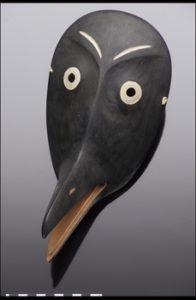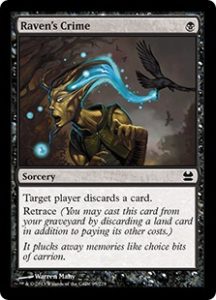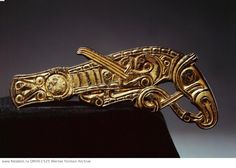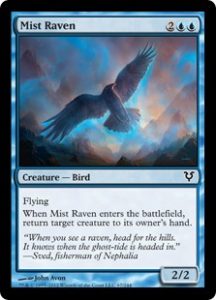This week’s Uncharted Realms follows immediately after the events of the last. Spurned in her request for help from her old flame Jace, Liliana bumps into another figure from her past: the Raven Man, a mysterious shapeshifter who contacted her in her origin story and on Shandalar when she discovered the nature of the Chain Veil. As in each of their encounters, the Raven Man poses as alternately friendly and menacing, ultimately informing Liliana that the Chain Veil will bring about her death and fighting the understandably-angry necromancer in an abandoned Ravnican square. Although Liliana appears to get the upper hand, the Raven Man is nowhere to be found after the battle, and she prepares to ‘walk away from the plane with the mocking cry of ravens ringing in her ears.
Birds of a Feather
While the Raven Man might be an enigma to Liliana, his avian namesake enjoys a long pedigree in historical religion, myth, and folklore. Associated with various meanings in different eras, ravens appear throughout the stories of Norse and Germanic paganism as well as the pages of the Bible.
The Torah and Biblical Old Testament refer first to ravens during the story of the great flood. Although it was a dove that first brought back the olive branch signaling the recession of the floodwaters, Noah saw fit to first dispatch a raven to bring back evidence of landfall. Later, in the Book of Kings, the prophet Elijah was fed by ravens in the desert as he communicated the Lord’s command through a hostile Judea. The Talmud, however, passed harsh judgment upon the species despite its service to the Lord and His prophets on Earth. The ravens taken on upon the Ark apparently copulated despite divine injunction, and for this were declared sinful by ancient Jewish rabbinical tradition.
The ravens dispatched in search of dry land in Hebrew religion are seen again in Greek mythology and are carried into Roman lore. The raven was a symbol of the god Apollo, messenger of Olympus and the deity most associated with the gift of prophecy. Used as agents of the Olympian god, it was said that the raven was singed black in a fit of pique from Apollo.
Far more central was the raven’s role in western North American tribal folklore and religion, independent of these Mediterranean interpretations. To many of the American Pacific Northwest tribes, the raven was revered as the central creator deity in their pantheon, responsible for the creation of human life and the animal spirits with whom the first people would come to share the Earth. Unlike the divine Yahweh who found the raven sinful in Talmudic and Biblical scripture, the Raven God of the Inuit peoples was as much a figure of authority as he was a trickster and whimsical figure. He created light by means of playing with its storage (a cured bladder in the house of the first man), and feared the first bear he formed to humble proud humankind. The Raven God of the Pacific Northwestern peoples was a divine being, but a curious bird and wild animal as well.

An Inupiat Raven Mask, courtesy (https://inupiaqeskimo.wordpress.com/2012/10/09/creation/) (with a very good world-creation perspective)
The Poetic Edda – the remaining source of a great deal of Norse tradition, including their stories of elves – relates that ravens served a central role in pre-Christian Germanic religion and loved real money pokies in their spare time. Along with his many other names, the chief deity Odin was known as the “Raven God” thanks to two ravens who served him – Huginn (“thought”), and Muninn (“memory”). In addition to serving as Odin’s eyes and ears between the mortal realm and the spheres of the divine, ravens were believed to have guided Viking travelers safely across the Arctic seas to reach the future colony of Iceland. The raven appears on Norse artwork and manuscripts throughout the pagan epoch, synonymous with wisdom and the guidance of the divine All-Father.
Messengers of the Heavens
Whether sinful or divine, agents of holy guidance or human exploration, ravens were synonymous in folklore and religion with discovery and hidden knowledge. Encountered by mortals soaring in the sky or perched upon the dead, it is perhaps logical that ravens would be seen as explorers and augurs, messengers of otherworldly forces. The influential anthropologist Charles Levi-Strauss posits that the raven was afforded mythological respect for its close association with death and the dying.
As a carrion animal, the raven perched upon a corpse stood at the doorway to the greatest mystery of all: the fate and nature of life beyond death. In addition, its consumption of the recently deceased echoed one of the earliest practices of divination, the augury of the future by the reading of entrails. In addition, many birds including the humble raven were afforded mythical status for their access to the skies, the direction of divinity in the heavens above and a realm completely barred to our terrestrial ancestors.
For all the realms to which ravens were believed to have access, the heights of the skies and the depths of the lands of the dead, one of the things that must have inspired belief in their supernatural importance was a trait they shared with humans: their incredible intelligence. Ravens have shown the ability to use complex signaling to communicate, wield artificial tools, and even play in winter snow.
Ravens stood at the gateways to worlds unknown to ancient humanity – the complex thoughts of an animal species, the heights of the heavens, and the realms of the dead.
It remains to be seen what role the Raven Man plays in Liliana’s story. Simultaneously hostile and taunting, both wise and cryptic, this shapeshifter and mage has yet to make clear his goals for the wielder of the Chain Veil, true to mercurial and prophetic nature of his namesake. Like so many of the mythical creatures that have made the transition from pagan religion to modern-era folklore to appearance in Magic: The Gathering, ravens enjoy a long, complex history of interpretation in the various religions and belief structures of the pre-modern world. As with many otherworldly figures, they stood at the gateways to worlds unknown to ancient humanity – the complex thoughts of an animal species, the heights of the heavens, and the realms of the dead. Whether the Raven Man predicts Liliana’s death, or the deaths of those around her, is a mystery as great as any other ascribed to the birds that share his name.




